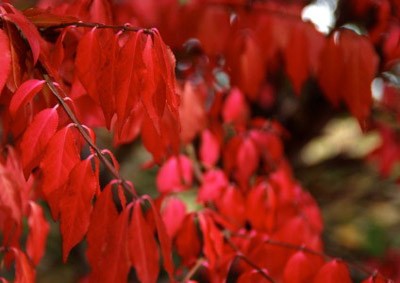
With its stunning autumn foliage and tolerance for neglect, Burning Bush (Euonymus) makes a wonderful ornamental addition to nearly any yard or garden. Here are some tips for growing and caring for burning bush in your landscape.
Plants labeled 'dwarf" or "compact" are usually assumed to be smaller versions of the same species. It's no wonder then, that many gardeners end up surprised by the irony associated with the name Euonymus alata "Compactus", a.k.a. "Dwarf Burning Bush". Capable of reaching a mature height and spread of 10 feet by 10 feet, the shrub is not exactly "dwarf" in size. Its namesake, "Dwarf", actually refers to the fact that the corky ridges found on its bark are much smaller and less distinctive than they are on the Euonymus species form. Good information to have before planting a row of them under your picture window.
Winged Burning Bush is easy to care for and considered essentially maintenance-free, at least until they outgrow their space. It is this ability to thrive in less-than-ideal conditions and subsequent tolerance for abuse (and pollution) that makes them such popular choices for the urban landscape.
Burning bush prefer to grow in a sunny spot, and in soil that is moist (not wet) and slightly acidic. Fortunately, they also adapt to partial shade, poor soil, dry soil, and the wrong pH, although each of these elements may adversely affect their fall color display.
Things to consider:
The rapid breakdown of hardwood mulch around the shrubs may result in a nitrogen deficiency (yellow leaves and slow growth). This can be remedied by yearly applications of fertilizer, or by switching to a mulch that decays more slowly.
Plants benefit from being fertilized annually in the spring before new growth begins. Have your soil tested first to determine existing nutrient levels before starting a fertilizer regime.
Burning bush growing in alkaline soil may develop mild leaf chlorosis (yellowing leaves). Like nitrogen deficiencies, this problem can also be remedied through a yearly application of the right type of fertilizer.
Prolonged stress like an extended summer drought may cause your burning bush to turn color prematurely.
Burning bush is generally trouble-free, but watch out for scale and powdery mildew.
The answer as to whether or not you should prune your burning bush depends entirely on your individual situation. Healthy growth does not depend on regular pruning, so in most cases, your shrubs will look best if left alone. However, when you need to control their size and shape (and eventually you will), pruning will become necessary.
Options:
Exposure: Sun/partial shade.
Soil: Not super fussy, but does need ample drainage.
Form: Shrub-like; starts with an upright growth habit becoming more rounded with age.
Foliage/bark: 1 to 3-inch long narrow leaves, finely serrated; medium to dark green in summer and turning flaming red (full sun) to pale pink (shade) in the fall. The bark has visible corky ridges on the regular-sized species, but is smaller and less distinctive on the so-named "dwarf" variety.
Flower/fruit: Inconspicuous flowers in late spring/early summer; produces tiny red-orange fruits in the fall that are attractive to wildlife.
Height/spread: Will slowly grow to 8 to 10 feet tall with a spread as wide ("Compactus"); other varieties may be much taller. Euonymus alatus 'Rudy Haag' is shorter - typically reaching 5 feet tall and 5 feet wide.
Growth rate: Slow to moderate.
Hardiness: Most varieties are hardy to zone 4.
Winged burning bush is native to northeastern Asia and was first introduced in North America as an ornamental plant in the 1860s. Although still considered a popular landscaping shrub, it is considered invasive in certain parts of the United States - especially in some Northeast states and New England.
Winged burning bush can invade a variety of disturbed habitats including forest edges, fields, and roadways. Once established, it can form a dense stand that chokes out native vegetation. Before planting burning bush, check the Invasive Plant Atlas of the United States to see if it is considered a threat in your area.
http://www.invasiveplantatlas.org/subject.html?sub=3023#maps

About The Author: Ellen Brown is an environmental writer and photographer and the owner of Sustainable Media, an environmental media company that specializes in helping businesses and organizations promote eco-friendly products and services. Contact her on the web at http://www.sustainable-media.com
Add your voice! Click below to comment. ThriftyFun is powered by your wisdom!
We have regular size burning bushes out front and they really are indestructable. We cut them back drastically every year and they keep growing. Great fall color!
I have one that is supposed to be a dwarf and so far it has not grown much at all. I have it on the east side of the house so it does not get full sun.
I planted 3 burning bushes late last summer and they looked great up until losing their leaves in the fall. This spring/summer they seem to be struggling to produce leaves. I tried fertilizing them and they perked up a bit, but then the leaves all disappeared, some of which were on the ground, others just gone. Any thoughts on what be causing this? Would rabbits rip off leaves and not eat them? I don't see any signs of having been chewed on, but can't think what else would be going on with my bushes!
I'm in zone 5 and have one burning bush plant that is beautiful. Can I plant this bush in the fall (since they're now on sale) or do I need to wait until spring? If I plant now (October), what do I need to do to ensure it survives? Thanks much!
Can I replant the burning bush? I have it close to my house and Im afraid it will get to big for the area that its in.
Add your voice! Click below to comment. ThriftyFun is powered by your wisdom!